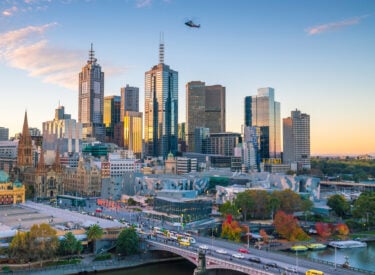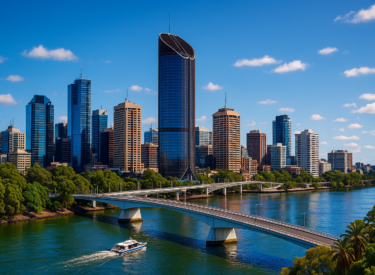
Key takeaways
We’re welcoming record migration—446,000 people last year alone—without planning for where they’ll live, work, or study.
This disconnect is fuelling an engineered housing and infrastructure crisis, not just a temporary shortage.
Developers aren’t the problem—they build when it makes financial sense.
But rising costs, regulatory hurdles, and planning delays make affordable housing in high-demand areas commercially unviable.
States depend on stamp duty, while the Federal Government relies on income tax funded by population growth.
This structural mismatch means neither level of government is properly incentivised—or equipped—to build the housing we need.
Most migrants want small, inner-city dwellings. Millennials want family homes closer to the city. But planning laws, NIMBYism, and cost pressures push development to the fringe—fueling congestion, sprawl, and poor liveability.
There’s a simple analogy I’ve often used to explain the current state of Australia’s housing crisis:
Imagine inviting half a million people to a party... and forgetting to organise more food, drinks, chairs, or even enough bathrooms.
That’s precisely what we’re doing as a nation: turning up the migration tap without planning for where all these new Australians will live, work, or go to school.
We’re not just creating short-term bottlenecks but engineering a long-term affordability crisis.
And it’s time we called it what it is: a complete policy disconnect between population growth and housing supply.
For weekly insights and strategic advice, subscribe to the Demographics Decoded podcast, where we will continue to explore these trends and their implications in greater detail.
Subscribe now on your favourite Podcast player:
The numbers tell the story: population growth outpacing housing
Since borders reopened post-COVID, migration has rebounded sharply—almost too sharply.
In 2023–24 alone, net overseas migration reached 446,000 people.
That’s equivalent to adding a city the size of Canberra in a single year.
Historically, we’ve called ourselves a “migration nation”—but the difference now is we’re simply not keeping up with the physical infrastructure required.
As demographer Simon Kuestenmacher put it in our latest Demographics Decoded episode, “We’ve had two decades of letting population growth outpace infrastructure and housing construction.”
It worked for a while. But now, the cracks are showing.
We’re short hundreds of thousands of dwellings.
Vacancy rates are at historic lows. Rents are skyrocketing.
And increasingly, first homebuyers are being priced out altogether, not because they don’t earn a decent living, but because demand is so far ahead of supply that any new stock is gobbled up before the metaphorical paint dries.
The real drivers of housing shortages: it’s not just “greedy developers”
Popular narratives often point fingers at greedy developers as the culprits.
But that’s lazy analysis.
As Simon noted, developers are actually straightforward in their business models.
“They’ll build whatever’s financially feasible, slap a 15–20% margin on it, and move on,” he said.
But right now, it’s not financially feasible to build affordable, medium-density housing, especially in the inner and middle-ring suburbs where demand is highest.
Why?
- Construction costs are up due to inflation and global material shortages.
- Labour is scarce and increasingly expensive.
- Finance is more expensive as interest rates rise.
- Regulatory costs are astronomical. The HIA has revealed that taxes, levies, and compliance costs can amount to over 50% of a new home’s price in some areas.
For example, in Sydney, hidden government costs can add nearly $300,000 to a new dwelling.
In Melbourne, it’s $156,000.
Brisbane? Still over $125,000.
These are not small numbers, and they don’t disappear when you ask builders to “be more affordable.”
Our tax system is rigged against affordability
Let’s dig deeper into that last point.
Both state and federal governments are financially addicted to the property sector:
- States rake in billions via stamp duty, which they’ve come to rely on more than ever, especially states like Victoria, whose debt levels have ballooned. Removing stamp duty without an alternative would blow a hole in their budgets.
- The Federal Government, meanwhile, is hooked on income tax. More than 50% of federal revenue comes from taxing workers’ wages. So it needs a growing, economically active population, which means it needs migration.
It’s a structural Catch-22.
The Feds need migration to sustain income tax revenue, but the states don’t have the tax flexibility or forward planning to build the homes or infrastructure that support it.
So each blames the other.
And nothing changes.
The type of housing we need is not being built
There’s another layer to this story: we’re not just not building enough homes—we’re not building the right kind of homes.
According to Simon, most new migrants are aged 18 and 39.
They arrive as singles or couples, not families.
They want small, high-density homes near universities, CBDs or employment hubs.
And yet, it’s still too hard to build this type of stock near the inner city, thanks to:
- Planning restrictions
- NIMBY opposition
- Outdated zoning rules
- Endless delays from local councils
Meanwhile, Millennials, who are now forming families, are seeking larger homes, usually 3- to 4-bedroom houses.
But they’re priced out of the inner and middle rings, so they move to the urban fringe.
It’s cheaper and faster to build there, but it comes at a long-term cost: transport, roads, schools, and hospitals must follow.
And they often don’t.
Simon explains that it costs three times more per square metre to build medium- or high-density housing in the inner suburbs than it does to bulldoze farmland and build at the fringe.
So developers go where the numbers make sense—and our cities sprawl further outward, adding to infrastructure backlogs and traffic congestion.
Planning is a major bottleneck, and it doesn’t need to be
In Melbourne and Sydney, especially, a deep flaw in our planning system exacerbates the crisis: state governments may set ambitious housing targets, but local councils have veto power over individual developments.
This creates political incentives to block new builds, especially in wealthy or stable neighbourhoods where long-term residents resist change.
Simon argues this is madness.
In his view, the entire planning approval process could be automated: “It’s just data. An AI could easily assess whether a development ticks the 498 regulations on the books.”
Yet instead, developers wait months, sometimes years, for approvals.
That delay adds holding costs, which ultimately get passed on to the buyer or renter.
If we want serious housing reform, we need to streamline planning and pull back local council powers.
Technology should be doing the heavy lifting here.
A national housing target? It’s time
Simon floated a fascinating idea during our discussion: what if we set a national housing affordability target?
Say, house prices should not exceed six times the median income, and let that guide all policy decisions!
Just as the RBA uses inflation targets to set monetary policy, we could use an affordability target to guide housing and immigration settings.
If prices exceeded the target, governments would be forced to implement policies that drive prices down, whether through increasing supply, re-zoning, or infrastructure investment.
Would it be politically palatable? Absolutely not.

Note: With two-thirds of Australians owning property, no political party would dare introduce policies that might reduce home values.
But the concept is sound, and it underscores the need for long-term thinking, something that’s woefully absent from today’s short political cycles.
What’s the real cost of doing nothing?
If we don’t fix this policy mismatch between housing and population, the consequences aren’t just economic—they’re societal.
- We’re creating an underclass of permanent renters.
- We’re concentrating growth in just a few capital cities, stretching infrastructure thin.
- We’re fueling resentment toward migrants, who are not the cause of the crisis, but its most visible symptom.
- And we’re locking future generations out of home ownership.
Simon sums it up well: “When you run policies in isolation, you create scapegoats and structural pain. If you increase migration, it must trigger a proportional increase in housing, infrastructure, and tax reform.”
So, where do we go from here?
Here’s what I believe must happen—urgently:
- Link migration policy to housing targets. This should be legislated, not left to political whim.
- Fast-track planning approvals using AI. There’s no excuse for 18-month delays in a digital world.
- Reform stamp duty. Replace it with a broad-based land tax to remove barriers to homeownership and mobility.
- Invest in high-density development near transport and employment. That’s what migrants and young workers want.
- Coordinate infrastructure investment with housing expansion. No more “build first, plan later.”
- Treat housing as a national economic strategy, not a byproduct. It's time to stop pretending this is just a planning issue.
Australia has no shortage of land, resources, or potential.
But unless we start treating population growth and housing supply as two sides of the same coin, we’ll continue to dig ourselves into a deeper affordability hole.
This is not about cutting migration or stopping development.
It’s about managing both with foresight, fairness, and long-term thinking.
And if we get this right?
The rewards—economic, social and strategic—will be enormous.
If you found this discussion helpful, don't forget to subscribe to our podcast and share it with others who might benefit.
Subscribe now on your favourite Podcast player:














